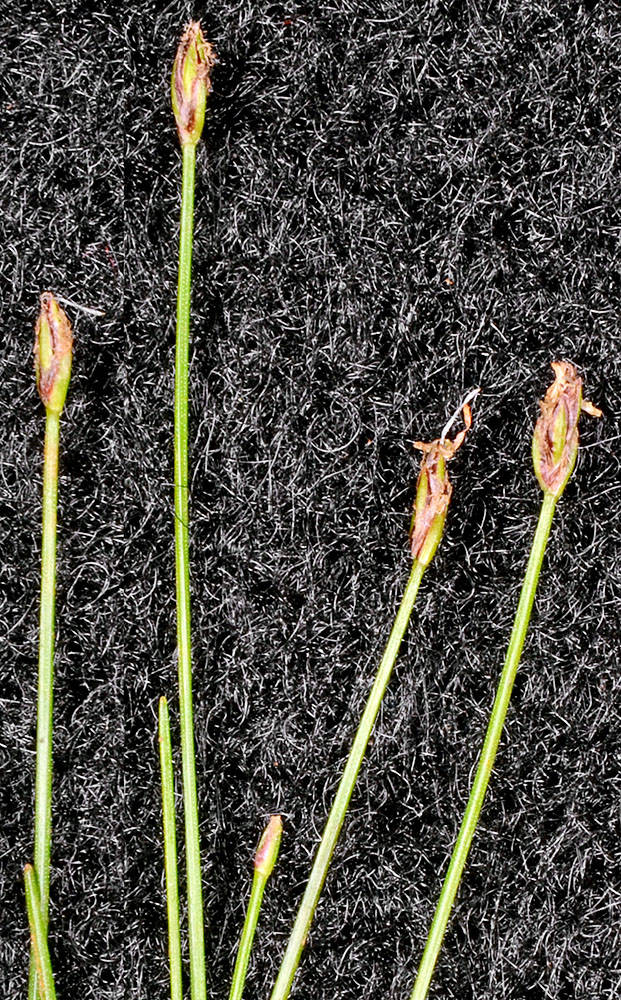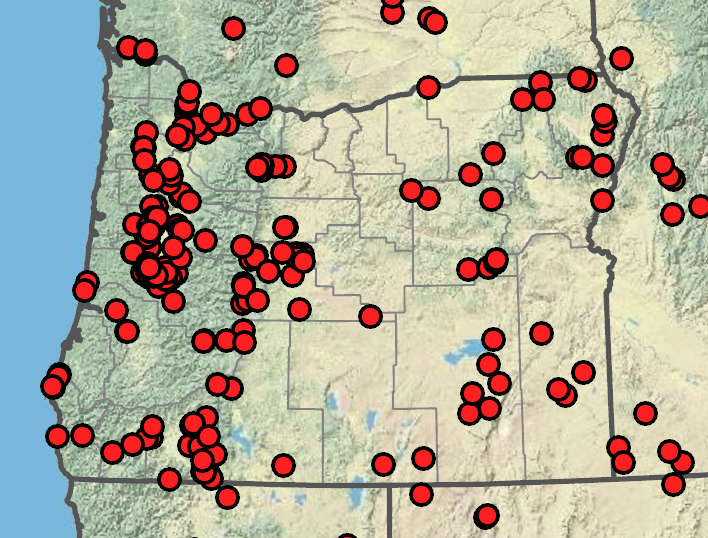Eleocharis acicularis
Eleocharis ovata
needle spikerush
ovoid spikerush
sometimes arching; terete to sometimes distinctly compressed, 1–60 cm × 0.2–0.5(0.7) mm.
terete, 2–35 cm × 0.3–1 mm.
2–8 × 1–2 mm; floral scales 4–25, 4–6 per mm of rachilla, 1.5–2.5(3.5) × 1–1.5 mm;
apex blunt to acute.
ovoid, 2–8 × 2–4 mm; floral scales 25–100+, approximately 10 per mm of rachilla, 1.5–2 × 1 mm; midribs often keeled in distal part of spike;
apex rounded to subacute.
perianth bristles mostly absent, uncommonly 2–4; shorter than to equaling achene;
anthers 0.7–1.5 mm;
stigmas 3.
perianth bristles present, rarely absent; (5)6–7, exceeding tubercle;
stamens 2(3);
anthers 0.3 mm;
stigmas 2 or some 3.
with angles plus about 8–12 obscure to prominent longitudinal ridges, narrowly to broadly obovoid to obpyriform, 0.7–1.1 × 0.35–0.6 mm; fine horizontal ridges 30–60, clearly evident to crowded and obscure; spaces between trabeculae sometimes translucent.
biconvex or to 33% greatly compressed trigonous, 0.75–1 × 0.6–0.85 mm.
often splitting;
apex rounded (to acute).
persistent, apex of distal leaf sheath obtuse to acute; tooth to 0.2 mm.
pyramidal to much depressed; (0.05)0.1–0.2 × 0.15– 0.25 mm.
deltoid, 0.3–0.5 × 0.3–0.5 mm, 60% to as high as wide, 33–67% as high and 50–75% as wide as achene.
=20.
=10.
Eleocharis acicularis
Eleocharis ovata
Ponds, shallow wetlands, and exposed shorelines and mudflats, vernal pools, and other, often disturbed wetlands. 0–2300 m. All ecoregions except Col. CA, ID, NV, WA; north to AK, east to Greenland and GA, south to South America; Australia, Eurasia. Native.
Plants of this species frequently grow as submerged or floating mats that do not flower. These plants differ from typical E. acicularis in having terete, smooth, soft, translucent culms with conspicuous partitions between the air cavities. Such plants are difficult to identify and can be confused with Schoenoplectus subterminalis. Eleocharis acicularis is highly variable, but much of the variation is probably environmental, dependent particularly on water depth. As a result of this plasticity, recognition of any of the described varieties is likely unwarranted. Eleocharis bella is similar but annual, cespitose, only occasionally produces rhizomes and has smaller floral scales, anthers, and achenes.
Freshwater shores exposed by seasonal low water levels, marshes, and disturbed wetlands. 100–1300 m. ECas, Sisk, WV. WA; north to British Columbia; northeastern North America. Native?
Pacific Northwest occurrences of E. ovata are disjunct from the species northeastern North American range. This may suggest that the species is introduced in Oregon. More research is needed.
Barbara Wilson, Richard Brainerd, Nick Otting
Barbara Wilson, Richard Brainerd, Nick Otting
- Local floras:
BC,
CA,
OR,
WA
- Local Web sites:
CalFlora,
CalPhotos,
Flora NW,
PNW Herbaria
WildflowerSearch
iNaturalist (observations)
USDA Plants Database
- LBJ Wildflower Center
- SEINet
- Plants of the World Online
- Encyclopedia of Life
- Wikipedia
- Google Image Search
- Local floras:
BC,
CA,
OR,
WA
- Local Web sites:
CalFlora,
CalPhotos,
Flora NW,
PNW Herbaria
WildflowerSearch
iNaturalist (observations)
USDA Plants Database
- LBJ Wildflower Center
- SEINet
- Plants of the World Online
- Encyclopedia of Life
- Wikipedia
- Google Image Search




